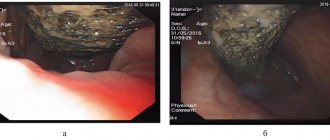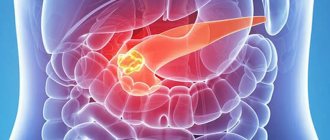Causes of development of autoimmune pancreatitis
- Autoimmune pancreatitis is a special form of chronic pancreatitis, primarily associated with damage to the pancreatic duct.
- Synonyms: primary sclerosing pancreatitis, lymphoplasmacytic sclerosing pancreatitis, non-alcoholic chronic pancreatitis with destruction of the pancreatic duct.
- Autoimmune pancreatitis occurs in all age groups;
- Slightly more common in men;
- According to European and American registries, pancreatitis occurs more often at a young age (35-40 years);
- In Asia, the disease most often affects older patients (60 years).
Causes:
- The pathogenesis of autoimmune pancreatitis is not clear;
- In more than 80% of cases there is a relationship with autoimmune disorders;
- The clinical picture of pancreatitis is varied;
- It differs from other forms of chronic pancreatitis by the presence of periductal lymphoplasmacytic infiltrates, which can lead to narrowing of the ducts and fibrosis;
- Often extends to the bile duct and can lead to lesions resembling primary sclerosing cholangitis.
Autoimmune pancreatitis: clinical case
We conducted a study of a patient with a difficult to diagnose pathology of the pancreas – autoimmune pancreatitis.
History, complaints:
A 72-year-old man had no active complaints. After taking a more detailed history, it was possible to find out that the patient periodically experiences abdominal pain, and the blood glucose level rises to 7-7.5 mmol/l. Denies cancer history. Before MRI of the abdominal cavity and retroperitoneal space, the patient underwent an ultrasound examination (not in our clinic); conclusion – pseudotumor form of pancreatitis.
What was revealed during the MRI study:
Diffuse (along its entire length) increase in the size of the pancreas, smoothness of its outer contour, deformation of the gland’s “sausage-shaped” shape. At the same time, no MR signs of the presence of additional space-occupying formations in the pancreas were identified according to native and post-contrast studies. The pancreatic duct is unevenly narrowed throughout. The common bile duct (choledochus) is narrowed in its lower third and unevenly expanded in the overlying sections. In addition, in both kidneys, numerous additional irregularly rounded formations with fairly clear, even contours were identified, having uniform low intensity in all scanning modes.
At the same time, enlarged lymph nodes and space-occupying formations of other localization were not detected at the visualization level.
What we discussed at the Skype meeting on this occasion:
Together with the doctors of our operating companies, we discussed this complex case. The doctors of our OCs identified all the above-described structural changes, and during further discussion we were able to come to a consensus.
Among various diseases that can give a similar MR picture, a differential series was built: a) pseudotumor pancreatitis; b) acute pancreatitis with an increase in the size of the pancreas; c) pancreatic tumor with the presence of secondary (metastatic) changes in the kidneys; d) pseudotumorous pancreatitis, which, first of all, has pancreatic (in the pancreas) changes, but also extrapancreatic ones - in particular, multiple focal changes in kidney tissue.
What conclusions were reached at the Skype meeting:
From the resulting differential series, OK doctors consistently excluded individual diseases. It was revealed that acute pancreatitis is not characterized by the absence of edema around the pancreas, and the clinical data do not correspond to the expected diagnosis. A pancreatic tumor is not characterized by the homogeneity of the gland tissue, the absence of data for its focal lesion, as well as the presence of a narrowed pancreatic duct (in tumors, as a rule, it is dilated); Also, the clarity of the contours and uniformity of the structure of focal changes in the kidneys are not characteristic of metastatic lesions.
There were 2 pathologies remaining in the differential series: pseudotumor and autoimmune pancreatitis. During the joint discussion, the doctors expressed arguments in favor of each of the remaining pathologies. At the same time, it was found that the totality of the identified signs, namely: smoothness of the contour, narrowing of the gland duct, narrowing of the common bile duct in the distal and its expansion in the proximal (upper) sections, as well as the presence of extrapancreatic changes are characteristic of autoimmune pancreatitis. What else needs to be done: taking into account the results obtained, it is necessary to recommend that the patient consult a gastrosurgeon. An additional examination is possible - RCP - an X-ray research method in which the pancreatic duct and bile ducts are filled with an X-ray contrast agent in order to better identify areas of their narrowing (stenosis). A biopsy of pancreatic tissue may also be required, followed by morphological examination.
What did the MRI method give in this case:
It is possible to assume with very high confidence the autoimmune nature of changes in the pancreas and exclude its tumor lesion. Given the autoimmune nature of the disease, these patients require hormonal therapy (glucocorticosteroids), after which the condition improves. Such therapy is not carried out for other diseases from the initially established differential diagnostic series.
Interestingly, in this case, the presence of changes outside the pancreas (kidneys) helps to make the correct diagnosis of autoimmune damage to the gland. The nature of the changes in the kidneys is focal autoimmune lymphocytic infiltrates.
Often, according to medical sources, an incorrect diagnosis of pancreatic cancer can lead to unjustified surgical intervention and removal of part of the gland (resection) or referral of the patient for treatment to an oncologist, which is also unjustified.
What is necessary for final confirmation/verification of the diagnosis: biopsy and morphological examination.
On the presented T2 images in axial (left) and coronal (right) projections, an increase in size and a “sausage-shaped” deformation of the pancreas is determined; the presence of numerous similar focal kidney formations.
Which method of diagnosing autoimmune pancreatitis to choose: CT, MRI, ultrasound
Selection Methods
- MRI, CT, RCP.
Pathognomonic signs
- Diffuse or circular enlargement of the pancreas occurs in the active phase;
- May develop as a pseudotumor;
- Diffuse or segmental stenosis, occupying more than a third of the length of the pancreatic duct;
- Stenosis of the distal segment of the bile duct occurs relatively often, sometimes clinically resembling primary sclerosing cholangitis;
- There is no peripancreatic effusion;
- Occasionally combined with phlebitis of the splenic vein.
Is an MRI of the abdominal cavity performed for autoimmune pancreatitis?
- The inflamed segment is hyperintense on T2-weighted images;
- In diffuse lesions, there is relatively uniform but reduced contrast enhancement;
- In circular focal forms, the affected areas accumulate less contrast;
- The wall of the distal part of the bile duct accumulates contrast;
- Pancreatic duct strictures are not clearly visualized on MRCP;
- Uninvolved parenchyma can probably be best assessed by injecting DPDFM.
a -c Autoimmune pancreatitis: a ) CT scan, arterial phase. Somewhat edematous pancreas with a narrow rim (arrow); b ) CT scan, portal venous phase. The image also shows a narrow rim around the slightly swollen pancreas. Splenic vein thrombosis (arrow); c ) MRI. After administration of DPDFM, areas of intact parenchyma are weakly and inhomogeneously enhanced
What will CT images of the abdominal cavity show in autoimmune pancreatitis?
- “Sausage-shaped” pancreas (loss of the usual lobular structure);
- The affected areas accumulate contrast less well.
a -c Autoimmune pancreatitis: a ) CT scan, arterial phase. Somewhat edematous pancreas with a narrow rim (arrow);
b ) CT scan, portal venous phase. The image also shows a narrow rim around the slightly swollen pancreas. Splenic vein thrombosis (arrow); c ) MRI. After administration of DPDFM, areas of intact parenchyma are weakly and inhomogeneously enhanced
What will RCCP show in autoimmune pancreatitis?
- More detailed visualization of areas of uneven narrowing, which are usually of greater extent.
a, b Autoimmune pancreatitis. RCP: a ) Extended stenosis of the pancreatic duct in the area of the head and its slight expansion in the area of the body of the pancreas; b ) Severe stenosis of the distal bile duct.
Why is an abdominal ultrasound performed for autoimmune pancreatitis?
- Focal or diffuse changes in the internal structure of the pancreas;
- Probably the best diagnostic method for performing a targeted biopsy.
Difficulties in diagnosing autoimmune pancreatitis. Modern approaches to treatment
For citation. Okhlobystin A.V. Is autoimmune pancreatitis difficult to diagnose? Modern concepts, approaches to treatment and outcomes // Breast Cancer. 2015. No. 21. pp. 1281–1286.
In recent years, the number of publications devoted to both clinical and pathogenetic aspects of autoimmune pancreatitis (AIP) has been continuously growing: if in 1995 there were only a few publications on the topic “autoimmune pancreatitis” in the PubMed system, in 2002 there were 2 dozen of them , since 2008 the count has been in the hundreds. More and more gastroenterologists, both physicians and surgeons, are becoming aware of this disease, and in a sense, it can be said that the diagnosis of AIP has become “fashionable.”
In addition, the difficulty of differential diagnosis is of additional interest - patients usually do not have typical clinical signs of pancreatitis. According to traditional views, it is believed that AIP occurs in men approximately 2–3 times more often than in women, and mainly after 50 years (Fig. 1) [1]. At the same time, the experience of domestic gastroenterologists, primarily Moscow clinics, shows that in most cases, AIP is diagnosed in women aged 30–40 years. It is not yet entirely clear what this discrepancy is due to - the characteristics of different patient populations or different approaches to diagnosis.
The possibility of pancreatitis caused by an autoimmune mechanism was first suggested by H. Sarles in 1961, calling the disease “primary inflammatory sclerosis of the pancreas” [16]. In the Marseille-Roman classification (1988), pancreatitis, characterized by an increase in the size of the gland, progressive fibrosis and mononuclear infiltration (which corresponds to the characteristics of an autoimmune one), was classified in the group of chronic inflammatory pancreatitis [17]. The term “autoimmune pancreatitis” (AIP) was first used by Kawaguchi [7] when describing a case of cholangitis involving the pancreas. Until now, Japanese gastroenterologists have the greatest experience in studying AIP. In case of AIP, various autoantibodies are detected in the blood serum: antinuclear factor, antilactoferrin, antibodies to carbonic anhydrase-2, rheumatoid factor, antibodies to smooth muscles [2]. The presence of autoantibodies against carbonic anhydrase, which is present not only in the gastrointestinal tract, but also in the kidney tubules and bronchial tree, may be the cause of combined immune damage to the digestive organs, kidneys and lungs [8, 19]. Similarly, lactoferrin is detected in many human tissues, including bronchial, salivary, gastric glands, and pancreatic acini. Lactoferrin may also act as a target antigen, inducing a cell-mediated immune response in this disease. The relationship between autoimmune and infectious factors is interesting: in AIP, antibodies to Helicobacter pylori proteins have been detected [6], which suggests the possible participation of Helicobacter in the pathogenesis of this disease.
Morphologically, the disease manifests itself as sclerotic changes in the pancreas, most often without pseudocysts or calcification/calculi, i.e., without signs of previous acute and/or alcoholic pancreatitis. At the same time, pancreatic stones are detected in almost 20% of patients with proven AIP [10]. Lymphoplasmacytic infiltration of the walls of the ducts, their narrowing and destruction are characteristic, and phlebitis is often observed. In AIP, diffuse, segmental and focal forms of pancreatic lesions are distinguished. In typical cases, inflammation covers more than 1/3 of the organ. As with other forms of chronic pancreatitis (CP), pancreatic calcification may occur. Thus, AIP is defined as a systemic inflammatory disease with severe fibrosis, which affects not only the pancreas, but also a number of other organs, including the bile ducts, salivary glands, retroperitoneal tissue, and lymph nodes. In the involved organs, lymphoplasmacytic infiltration is observed (cells stain positive for IgG4), and the disease responds successfully to treatment with steroid drugs [3].
Morphologically, AIP is manifested by lymphoplasmacytic infiltration and pronounced sclerosis; abundant (more than 10 cells per field of view) infiltration of pancreatic tissue with lymphocytes with 2 or more of the following signs: periductal lymphoplasmatic infiltration, obliterative phlebitis, vortex fibrosis. In 2009, 2 forms of AIP were described: lymphoplasmacytic sclerosing pancreatitis and idiopathic periductal pancreatitis [20]. For both forms, the key morphological feature is not a large number of lymphocytes or plasma cells that stain positive for IgG4, but a predominant lesion of the pancreatic ducts: the concentration of these plasma cells around the ducts is important, while the uniform distribution of these cells throughout the pancreatic tissue, even in large numbers (> 10 in the field of view), is not enough to diagnose AIP. Type I AIP – pancreatitis with a predominance of sclerosis with the participation of lymphocytes and IgG4-positive plasma cells; Type II – with a predominance of idiopathic destruction of the ducts. In type I AIP (lymphoplasmacytic sclerosing pancreatitis), the ductal epithelium is preserved, and obliterating phlebitis is pronounced. In type II AIP (idiopathic ductal-concentric pancreatitis), granulocytic destruction of the ductal epithelium is determined, periductal lymphoplasmic infiltration is characteristic, as well as infiltration of the ductal wall with neutrophils like microabscesses, phlebitis and fibrosis are less pronounced. There is usually loss of lobular structure, minimal reaction of peripancreatic fat, and rarely enlarged regional lymph nodes (Fig. 2).
A large number of patients experience a significant enlargement of the head of the pancreas, which leads to compression of the common bile duct; very often, abdominal pain is absent at all or is of an erased nature. Acute AIP and severe pancreatitis are rare. With destructive forms, it becomes difficult to carry out morphological verification of the diagnosis. Patients, as already noted, do not have typical clinical signs of pancreatitis; they consult a doctor about minor abdominal pain, general weakness, jaundice, and dry mouth (Fig. 3). Such symptoms, which first appeared in an elderly person (in about 1/3, the disease begins after the age of 60 years) in combination with signs of obstructive jaundice and diabetes mellitus, require excluding the diagnosis of pancreatic cancer (PCa) and bile ducts. So far, in most cases of proven AIP, the disease is detected by histological examination of surgical material obtained during pancreatic resection for a suspected tumor. In AIP, an increase in IgG4 levels is not always detected: according to various sources, this occurs in 53–95% of cases. Initially, a convincing assumption about AIP can be made without morphological verification only in the case when the patient has a total (diffuse) form of AIP. In this case, computed tomography (CT) reveals the so-called “sausage-shaped pancreas” with a characteristic hypodense rim in the parenchymal phase of contrast, which is explained by the predominance of inflammatory and fibrotic changes along the periphery of the pancreas tissue and a corresponding disturbance in perfusion (Fig. 4).
The greatest difficulties in establishing a diagnosis arise in patients with focal forms of AIP, for which another name for AIP – “inflammatory pseudotumor” – is very appropriate. The initial symptoms of the disease: jaundice, weight loss, pain, which do not have a clear connection with food intake and are generally uncharacteristic of CP, also suggest more likely a pancreatic tumor. Serum parameters for both diseases are characterized by low specificity: an increase in the level of the tumor marker CA-19-9 is detected in 40% of patients with AIP; at the same time, the most well-known laboratory indicator of AIP IgG4 turns out to be normal in 1/4 of patients with proven disease and increases in every tenth patient with pancreatic adenocarcinoma (Table 1). In focal forms, pancreatic puncture is mandatory - not so much to confirm AIP, but to exclude a malignant tumor. Most often, taking into account the fact that in both cases the head of the pancreas is most often affected, EUS with puncture of the pancreas is indicated. Depending on the characteristics of the patient and the experience of the clinic, collection of histological or cytological material can be performed during laparoscopy, transabdominal or intraoperative. It is important to take into account the heterogeneous nature of the lesion in both autoimmune and neoplastic processes, so false-negative or indeterminate results are often encountered. Often, the diagnosis of AIP is made by examining surgical material after resection of the pancreas performed for cancer. Both in foreign and domestic practice, there are frequent situations when the obvious preoperative diagnosis of a tumor, sometimes metastatic, involving lymph nodes, liver and other parenchymal organs, is not confirmed morphologically after resection - instead of tumor cells, sclerosis with lymphoplasmacytic infiltration is found (Table. 2).
AIP typically involves damage to other organs. In this regard, type 1 AIP is often considered as part of a systemic IgG4-associated disease, which also includes damage to the bile ducts (both intra- and extrahepatic), fibrosis of the retroperitoneal tissue, enlargement of the salivary and lacrimal glands, mediastinal lymphadenopathy, pleura. AIP is often accompanied by damage to the bile ducts in the form of individual or multiple narrowings, caused at the initial stage by periductal lymphoplasmacytic infiltrates, which most often affect the confluence of the ducts, extrahepatic ducts, the gallbladder and the terminal part of the common bile duct. Unlike primary sclerosing cholangitis (PSC), which is characterized by band-shaped narrowing of the ducts, localized strictures, or a “burnt wood” appearance of the ductal system, AIP should be suspected when there is diffuse or extensive segmental narrowing of the intrapancreatic part of the common bile duct. One of the problems is the frequent combination of AIP and PSC, which makes differential diagnosis and choice of treatment tactics difficult. The most characteristic feature of AIP is the rapid regression of changes in the biliary tract and symptoms after the administration of steroids, which is not typical for PSC. It is important to remember that a 2-fold increase in serum IgG4 levels, subsidence of symptoms after the start of steroid therapy, as well as tissue infiltration of IgG4 plasma cells are not specific for AIP. Similar changes can occur during various autoimmune, inflammatory and tumor processes in the body. In the differential diagnosis, it is important to rely on the plasma cell IgG4/IgG ratio (should be >40%) [5] and the predominant infiltration around the ducts.
Currently, there are a large number of national diagnostic criteria for AIP in the world: American (Mayo Clinic criteria), Japanese, Korean, United Asian, German (Mannheim criteria) [18]. The most carefully developed and widely used criteria are HiSORt, developed at the Mayo Clinic under the leadership of S. Chari [4]. The HISORt system includes the following groups of features: – Histology – periductal lymphoplasmacytic infiltrate with obliterating phlebitis, fibrosis in the form of swirls and/or lymphoplasmacytic infiltrate with fibrosis in the form of swirls and a large number of IgG4+ cells (≥10 IgG4+ cells in the field of view); – Imaging: diffuse enlargement of the pancreas with delayed accumulation of contrast in the form of a “rim”, diffuse unevenness of the main pancreatic duct (MPD); – Serology: increased serum IgG4 levels (8–140 mg%); – Other organ involvement: bile duct strictures, fibrosis of retroperitoneal tissue, damage to the salivary/lacrimal glands, mediastinal lymphadenopathy; – Response to steroid therapy: rapid positive effect of steroid therapy per os. Diagnostic criteria give the following levels of probability for diagnosing AIP: Level A: typical histological features. The presence of 1 or more of the following signs: – an area of tissue with characteristic features of lymphoplasmacytic sclerosing pancreatitis; – ≥10 IgG4+ cells per field of view against the background of lymphoplasmacytic infiltration. Level B: typical laboratory and instrumental data. The presence of all signs: – diffuse enlargement of the pancreas according to CT / magnetic resonance imaging (MRI) with delayed contrast enhancement and the presence of a rim (“capsule”); – diffuse unevenness of the lumen of the gastrointestinal tract during endoscopic retrograde pancreaticography; – increased serum IgG4 levels. Level C: positive response to steroid hormones. Presence of all signs: – exclusion of all other causes of pancreatic damage; – increased serum IgG4 levels or damage to other organs, confirmed by the detection of a large number of IgG4+ cells; – disappearance/significant improvement of pancreatic or extrapancreatic changes during steroid therapy. It is important that ex juvantibus diagnosis by trial of steroid therapy is used only when it is certain that a tumor is absent. Fine-needle biopsy is insufficient to determine the type of AIP (sensitivity is 33%), as well as for the differential diagnosis of AIP and pancreatic adenocarcinoma. The “gold standard” is to obtain morphological material during core needle biopsy, marginal biopsy, or after resection of the pancreas.
Treatment The main goals of therapy for AIP are, on the one hand, suppression of inflammatory infiltration, on the other - as with pancreatitis of other etiologies - relief of symptoms and replacement therapy for exocrine pancreatic insufficiency (EPI). The question of whether it is advisable to treat patients with asymptomatic and uncomplicated forms of AIP has not yet been finally resolved. Prescribing steroids for therapeutic purposes ensures relief of clinical symptoms of pancreatitis or extrapancreatic lesions, restoration of the size and structure of the pancreas (in the absence of pronounced fibrosis). The minimum effective dose of prednisolone for AIP is 30–40 mg/day. The clinical effect usually occurs within 2–3 weeks. from the start of treatment, normalization of laboratory and instrumental data – after several weeks – months (Fig. 5). The duration of steroid therapy depends on the clinical response, side effects, the presence of concomitant autoimmune diseases, and the need for their treatment. Steroid therapy is usually effective in cases of damage to the bile ducts and salivary glands. Only in rare cases does the condition of patients improve spontaneously without the use of any medications.
It should be noted that since glucocorticosteroids (GCS) began to be successfully used to treat AIP, little is still known about the subsequent condition of patients after achieving clinical remission. T. Nishino et al. conducted a study of the long-term results of steroid therapy [13]. The authors observed 12 patients for more than 1 year. Initially, an increase in the size of the pancreas and an uneven narrowing of the Wirsung duct were noted in all patients, narrowing of the common bile duct – in 10. All patients received prednisolone at an initial dose of 30–40 mg/day with its subsequent reduction. Normalization of pancreatic dimensions and resolution of Wirsung's duct stenosis were noted in all patients. Strictures of the bile ducts decreased to varying degrees in all cases, however, in 4 of them, strictures of the terminal part of the common bile duct persisted for a long time (40%). Subsequently, there were no relapses of AIP. Pancreatic atrophy developed in 4 (33%) patients out of 12. Deterioration of exocrine pancreatic function during GCS therapy and episodes of drug-induced pancreatitis were not observed in any of the patients. This suggests that most patients with AIP benefit from steroid use in the long term. Long-term therapy with prednisone requires monitoring the course of the disease, including assessment of symptoms, diagnosis of disorders of exo- and endocrine function of the pancreas, monitoring of IgG4 levels, pancreatic size and condition of the ducts according to CT/MRI (Fig. 6). Attempts are being made to use azathioprine [11], mycophenolate mofetil [9] and methotrexate [14] to maintain remission. However, the effectiveness of these drugs, unlike prednisolone, has not been proven in clinical studies. In patients with refractory disease, rituximab is used [15], which reduces the number of B-lymphocytes, which ensures a rapid clinical response and a decrease in IgG4 levels.
With a morphologically verified diagnosis of AIP, it is possible to recommend expanding therapy to include enzyme preparations and proton pump inhibitors (PPIs) in the regimen (in addition to prednisolone). For symptomatic purposes, antispasmodics and non-steroidal anti-inflammatory drugs can be used according to indications. According to K. Tsubakio et al. (2002), a clinical effect was obtained from the use of ursodeoxycholic acid drugs in AIP occurring with cholestasis syndrome against the background of stenosis of the terminal common bile duct [21]. The drug at a dose of 12–15 mg/kg can be effectively used for AIP, especially when the biliary system is involved in the pathological process. With a significant increase in the pancreas and impaired outflow of pancreatic secretions, the prescription of pancreatic enzymes, antisecretory drugs and antispasmodics is indicated according to the regimen used to treat the painful form of CP. It is recommended to take encapsulated drugs in the form of microtablets. In Russia, a modern micro-tabletted enzyme preparation is presented on the market - Ermital®, which is produced in Germany. The following dosages are available: 10,000 units. (10,000 Units of lipase, 9,000 Units of amylase and 500 Units of protease), 25,000 Units. (25,000 units of lipase, 22,500 units of amylase and 1250 units of protease) and 36,000 units. (36,000 units of lipase, 18,000 units of amylase and 1200 units of protease). Ermital has different forms of packaging, incl. cost-effective No. 50. The high content of proteases makes it possible to more effectively relieve pain compared to other enzyme preparations, as well as reduce the number of capsules taken. The drug Ermital contains microtablets that have a low threshold pH level for the dissolution of the enteric coating, which ensures early activation of trypsin in their composition and more effective pain relief. Many years of experience with the use of the drug Ermital have shown that it is well tolerated by patients and does not cause serious side effects. An important advantage of the drug is the absence of phthalates in the microtablet shell, which are dangerous during pregnancy (cause disturbances in the development of the nervous and reproductive systems of the fetus).
For the purpose of pain relief, as well as for replacement therapy, Ermital is recommended to take 25,000–40,000 units. (for example, 25,000 or 36,000, 1 capsule 4–5 r./day) with main meals (at the beginning of a meal) and 10,000–25,000 units. (1 capsule of Ermital 10,000) when taking a small amount of food. According to observations in our clinic, monotherapy with Ermital in 73 patients with CP, including autoimmune etiology, for 1 month. caused a significant decrease in pain intensity, in 30 patients (61%) the pain disappeared completely. Since acute forms with destruction of the pancreas are extremely rare, hunger, antibacterial drugs are usually not required. If the patient experiences symptoms of obstructive jaundice, external or endoscopic retrograde drainage may be required, especially if there is a bacterial infection. If minimally invasive approaches to resolving jaundice are unsuccessful, the patient may undergo cholecystoentero- or hepaticoenterostomy [1].
Despite the fact that AIP does not have many of the characteristic clinical manifestations inherent in pancreatitis of other etiologies, this variant of the disease also results in exocrine pancreatic insufficiency. This is explained by the destruction of the functionally active parenchyma of the pancreas: antibodies to trypsinogens 1 and 2, a number of other acinar antigens were detected: amylase α-2A, lactoferrin, pancreatic secretory trypsin inhibitor, leptin. In patients, a decrease in the number of trypsin-containing acinar cells was detected. Severe fibrosis of the pancreas can also contribute to the development of the problem. According to existing data, 34% of patients with AIP develop EPI after 3 years. Adequate replacement therapy (Fig. 7) should ensure complete relief of symptoms and normalization of trophological status. For this purpose, the administration of micro-tablet enzymes (such as Ermital) at a dose of 36,000 units is indicated. with each meal, i.e. 5–6 rubles/day. total daily dose 180,000–216,000 units. Subsequently, the dose of enzymes is adjusted to achieve normalization of body mass index and other trophological indicators (for example, the level of retinol-binding protein). The duration of taking enzyme preparations is not limited. Moreover, it should be remembered that the pancreas does not have the ability to regenerate, and if relief of an exacerbation requires a course of therapy for 1–3 months. (in severe cases – up to six months), then EPI replacement therapy is prescribed for life. If replacement therapy is insufficiently effective, the daily dose is gradually increased, primarily due to a greater frequency of food intake and enzymes. Improves the action of digestive enzymes, both exogenous and endogenous, by prescribing drugs that reduce gastric secretion. Usually, PPIs are used in half or standard dose (omeprazole 10 or 20 mg twice a day).
The greater effectiveness of microtablet enzymes against pain may be associated with the elimination of dyskinetic disorders in the digestive system (small and large intestines, gall bladder) and secondary absorption disorders. Thus, correction of pancreatic maldigestion/malabsorption and elimination of motility disorders can reduce pain (Fig. 8).
Conclusion Thus, according to the modern classification of CP, AIP is identified as an independent nosological form; its pathogenesis is caused mainly by autoimmune disorders along with genetic and infectious factors. This form of CP is characterized by an increase in the level of serum γ-globulin or IgG, the presence of autoantibodies and a diffuse enlargement of the pancreas, a diffuse uneven narrowing of the gastrointestinal tract. Therapy with corticosteroids is effective in reducing inflammation in the pancreas, but the long-term effects of steroids in relation to AIP are still poorly studied. When carrying out enzyme replacement therapy, as well as pain relief, the drug Ermital showed high effectiveness. It is distinguished by a high content of proteases, which makes it possible to more effectively relieve pain compared to other enzyme preparations, as well as reduce the number of capsules taken.
What diseases have symptoms similar to autoimmune pancreatitis?
Pancreas cancer
— Obstruction of the pancreatic duct in a short segment, accompanied by its expansion;
— The tumor usually does not enhance with contrast; at an early stage, signs of parenchymal infiltration are detected
Chronic pancreatitis
— Dilatation of the pancreatic duct and the presence of calcifications
Acute pancreatitis
- Almost always accompanied by significant peripancreatic effusion









